Come and Visit Mars
Human Historical Observations
Mars is easily visible from Earth. It was known to the ancients, who named it after the god of war, probably due to its red coloration.Mars was first observed through a telescope by Galileo in 1610, the same year he saw Jupiter's four largest moons, and Saturn's "triple planet" system, later shown to be rings. Christiaan Huygens in 1644, observed the first reliable feature on Mars, a V-shaped marking (now recognized as Syrtis Major). He also was able to determine that Mars's rotational period was very nearly 24 hours. Giovanni Cassini also observed Mars and noticed that after 37 days, the same features were visible at the same time of night, concluding the rotation period of Mars to be 24 hours and 40 minutes, proving that the markings he saw were not illusions. In 1672, Huygens observed a polar cap at the south pole of Mars. In 1686, Bernard le Bovier de Fontenelle published a book in which he speculated about the conditions of life and the nature of the inhabitants of the Moon, Mercury, and Venus. He gave cursory attention to Mars, however, saying only that "Mars has nothing curious that I know of; its days are not quite an hour longer than ours, and its year's the value of two of ours. It's smaller than the Earth, it sees the Sun a little less large and bright than we see it; in sum, Mars isn't worth the trouble of stopping there." Rather ironic, when you consider the incredible speculation just two centuries later.
A period of 75 years passed after Huygens' death before major improvements in telescopes provided us with a better view of Mars. William Herschel observed Mars in 1777 and reported two remarkable bright spots on Mars - the polar caps. In 1781, Herschel discovered Uranus. In between observations of Uranus over the next two years, Herschel observed Mars, confirming that the polar caps were not exactly at the poles, more accurately determining the rotation period, and discovering that Mars's axis of rotation was tilted at nearly the same angle as that of the Earth's (25 degrees versus 23.5 degrees), implying that Mars had seasons. Herschel drew some of Mars's features during his observations, several of which can be ascribed to fixed features on the surface of the planet. Some, however, were short-lived. Were they figments of his imagination, plants blooming and dying with the seasons, clouds, or other temporary features?
An enthusiastic amateur astronomer, Johann Hieronymus Schroeter, began to observe Mars in 1785. His observations showed hazy patches with indistinct edges. When he was finally able to use Herschel's large telescope, he wrote "The spots and streaks on the globe of Mars are always changing, even from hour to hour. But that they are the same regions is shown by the fact that the same shapes and positions develop and pass away again, as one would expect of the variable atmospheric appearances occurring above a solid surface." Unfortunately, his drawings were showing Syrtis Major in clearly recognizable form. Schroeter's failure to recognize it only testifies to the difficulty of perceiving an unfamiliar object correctly and the strong influence of fixed ideas.
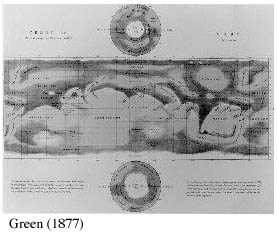 In 1837, Wilhelm Beer and Johann Heinrich Mädler sketched dark patches on
the planet near the north polar cap. These patches seemed to change over
time, and may have been the first convincing observations of Martian dust
storms (though at the time they were attributed to marshy land). Over the
next several decades, the telescopes got better, and more people were
interested in astronomy, leading to the next great Mars craze...
In 1837, Wilhelm Beer and Johann Heinrich Mädler sketched dark patches on
the planet near the north polar cap. These patches seemed to change over
time, and may have been the first convincing observations of Martian dust
storms (though at the time they were attributed to marshy land). Over the
next several decades, the telescopes got better, and more people were
interested in astronomy, leading to the next great Mars craze...
In 1877, Asaph Hall discovered both the moons of Mars, Phobos and Deimos, from the US Naval Observatory in Washington DC. Nathaniel Green, an amateur astronomer and professional portrait artist, drew up a map and also noted brightenings at the limb and terminator which he identified correctly as morning and evening clouds.
That same year, Italian astronomer Giovanni Schiaparelli made an excellent map of Mars based on his observations. He labeled some of the new, predominantly linear features canali (channels). It is clear that Schiaparelli had completely natural features in mind, as he often used the word fiume (river) as a synonym. His observations, mistranslated by the English as canals, were to have far-reaching consequences.
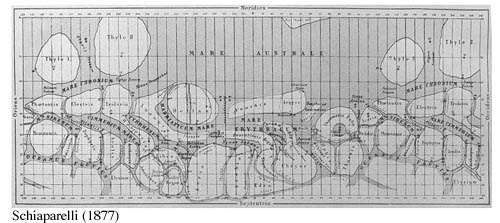
Many observers in the years just after Schiaparelli's new map were unable to see the canals, prompting much debate as to the appearance and disappearance of the features on the planet. Seas rising, deserts expanding, and clouds forming were all put forth as reasons for the changing landscape. In the late 1880s, a prize was even offered to "the person of whatever nation who will find the means within the next ten years of communicating with a star (planet or otherwise) and of receiving a response."
Stories of canals, seas, lakes, and even vegetation stimulated Percival Lowell to found his Arizona observatory and search for life on Mars. He believed that Mars was inhabited even before he built his observatory. Shortly after establishing the observatory in Flagstaff in 1894, he observed his canals on Mars, made note of seas and islands near the melting polar caps, as well as vegetation. Lowell writes:
-
When we put all these facts together, the presence of the spots at
the junctions of the canals, their apparent invariability [in] size, their
seasonal darkening, and last but not least the resemblance of the great
equatorial regions of Mars to the deserts of our Earth, one solution
instantly suggests itself of their character, to wit: that they are oases
in the midst of that desert.
Here then we have an end and reason for the existence of canals and the most natural one conceivable---namely that the canals are constructed for the express purpose of fertilizing the oases. . . . And just such inference of design is in keeping with the curiously systematic arrangement of the canals themselves. . . . The whole system is trigonometric to a degree.
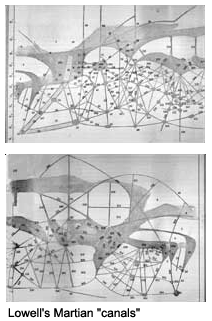 To Lowell, Mars was becoming a desert planet, inhabited by beings
who, in order to survive, had had to built a vast system of
irrigation canals to transport water from the melting polar caps.
To Lowell, Mars was becoming a desert planet, inhabited by beings
who, in order to survive, had had to built a vast system of
irrigation canals to transport water from the melting polar caps.
He wrote a series of articles for the general and scientific press, and published his results in a book called "Mars" in 1895. Needless to say, it created an immediate sensation.
For several decades, Schiaparelli's and Lowell's observations prompted Mars-mania among the general public. Not all astronomers were so convinced. During the same period that Lowell made his first observations, other astronomers were reporting no canals - nothing at all that resembled the straight lines of Lowell's drawings. But momentum was with Lowell, and many other observers "saw" canals, though some were broad and curving, rather than thin and straight. As the years went by, and telescopes improved, the reports of canals became more infrequent. Observers described entirely natural-looking markings, perhaps long and thin, but not the network of straight lines that Lowell believed in.
Ultimately, the solution to the canal mystery belonged more to the realm of perceptual psychology than to astronomy. The canals were seen in short glimpses; they were fragmentary perceptions. A collection of markings that the human eye and brain connect into a series of lines. Modern observers, especially those with small telescopes will continue to have fleeting glimpses of the canals from time to time.
Human Robotic Exploration
Up until the 1960s, the darker areas of Mars were still believed to be vegetation. That all ended with Mariner 4 (launched on November 28, 1964, the 305th anniversary of the day Christiaan Huygens drew a rough sketch of the Syrtis Major region). Images returned from Mariner 4 showed a distinctly cratered surface - and not one canal. Radio data from the satellite showed the Martian atmosphere to be less than 1% the pressure of the Earth's. Mars was less like the Earth and more like the Moon! There was clearly no room for flowing water and vegetation. But Mariner 4 had only photographed 1% of the planet.In late July and early August of 1969, only a few days after Neil Armstrong and Buzz Aldrin landed on the Moon, Mariners 6 and 7 flew by Mars, photographing larger sections of the planet - up to 10% of the surface. In addition to the expected craters, these two new missions observed chaotic terrain, areas that appeared to have formed by the withdrawal of subsurface material and collapse of the overlying sediments and rocks. Mariners 6 and 7 had photographed the "dark" areas of Mars (the ones previously held to be vegetation), but entirely missed some of the most interesting terrain. That was still to be discovered.
Huge mountains, craters, rifts and storms...
The next mission to visit Mars was Mariner 9, which arrived in orbit around Mars in 1971 amid a global dust storm. These storms arise frequently during Mars's perihelion, and the cameras on Mariner 9 were shut down during the duration of the storm in order to conserve energy. Eventually, the dust began to settle and Mariner 9 turned on its cameras. The dark spots seen from Earth were huge shield volcanoes! Dry river beds, channels and tributaries strongly suggested that conditions on Mars were once very different! There was a huge canyon, 4,000 km long - 1/4 the circumference of the planet! Mars was revealed not to be like the Earth or the Moon - Mars was its own planet.
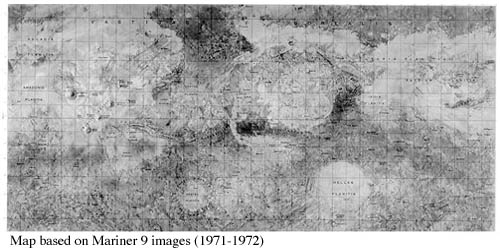
After the amazing results from Mariner 9, the search for life began. Scientists realized that to find life on Mars was pretty unlikely, given its present conditions, but it was not totally out of the question. After all, the evidence for liquid water in Mars's past was quite convincing. The Viking orbiters and landers were launched toward the red planet in 1975. Viking 1 reached Mars orbit on Jun 19, 1976, and the lander safely set down on July 20, seven years to the day after the first Moon landing. This lander provided us with our first up-close view of the surface of Mars.
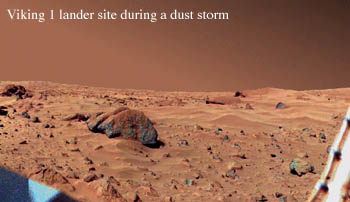
Several biological experiments were performed by the Viking lander, the results of which were confusing. One experiment performed by the Viking rovers seemed to show evidence of microbial life in the Martian soil. Other experiments, though, showed no signs of life, so the positive result was thought to be due to an unknown chemical reaction within the soil sample. Recently (2001), a reanalysis of this data has shown tantalizing evidence for the presence of a circadian rhythm in the reaction. This is consistent with what would be expected if a living organism were responsible for the readings. NASA has made the original data file available to researchers and the general public, so this intriguing finding can be tested and scrutinized further.
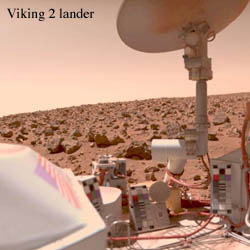 In September, Viking 2's lander set down 7,400 km to the northeast of
Viking 1. Scientists back on Earth were greeted by a view of rocks
similar to Viking 1. But the rocks were different - appearing more like
volcanic rock, with pits and cavities possibly created around small gas
bubbles in volcanic lava. Although the landers were only designed for a
90-day lifetime, both landers continued to operate for several years,
with Viking 1's lander holding the record - it remained in contact until
November 13, 1982.
In September, Viking 2's lander set down 7,400 km to the northeast of
Viking 1. Scientists back on Earth were greeted by a view of rocks
similar to Viking 1. But the rocks were different - appearing more like
volcanic rock, with pits and cavities possibly created around small gas
bubbles in volcanic lava. Although the landers were only designed for a
90-day lifetime, both landers continued to operate for several years,
with Viking 1's lander holding the record - it remained in contact until
November 13, 1982.
Mars Pathfinder landed on the surface of Mars on July 4, 1997 and its rover, Sojourner, investigated the vicinity of the landing platform. Many studies were performed by Pathfinder, including soil and rock chemistry studies, weather, wind, dust, and atmospheric experiments, and identification of albedos and rock types. Engineering milestones of the mission included demonstrating a new way of delivering a spacecraft to the surface of Mars by way of direct entry into the Martian atmosphere using a parachute and airbags to cushion the impact. In addition, Mars Pathfinder demonstrated for the first time the ability of engineers to deliver a semi-autonomous roving vehicle capable of conducting science experiments to the surface of another planet. Pathfinder's lander (now known as the Sagan Memorial Station) operated 3 times its 30-day nominal lifetime, and the rover, Sojourner, operated 12 times its expected lifetime of 7 days.
Mars Global Surveyor began mapping and photographing the surface of Mars in unprecedented detail in 1997. It produced the highest integrity global topographic model for any planet including Earth, that reveals the 30-km pole-to-pole slope that controlled the transport of water in early Martian history, and the flat northern hemisphere, that may represent the location of a large ancient ocean. It also produced the first reliable estimate of the present-day surface water inventory from the volumes of the polar caps, and clear evidence for a sapping origin of many channels from probable melting of ground ice.

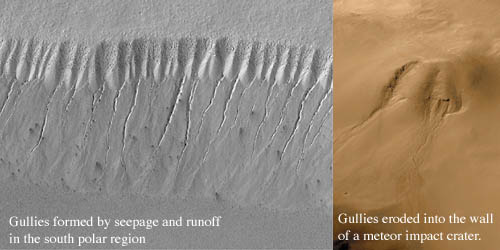
The incredibly robust rovers, Spirit and Opportunity, each exceeded their 90-day design lifetime by many years. With data from the rovers, mission scientists have reconstructed an ancient past when Mars was awash in water. Spirit and Opportunity each found evidence for past wet conditions that possibly could have supported microbial life.
The Curiosity rover is the largest rover ever sent to Mars (it's the size of an SUV) and is still operating. Curiosity set out to answer the question: Did Mars ever have the right environmental conditions to support small life forms called microbes? Early in its mission, Curiosity's scientific tools found chemical and mineral evidence of past habitable environments on Mars. It continues to explore the rock record from a time when Mars could have been home to microbial life.
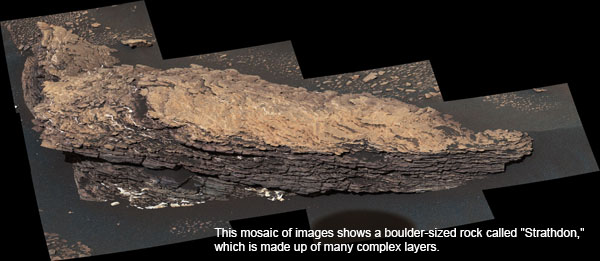
Future Human Visitation
We see you've sent ahead some things...
The Perseverance rover (launched in 2020) takes the next step by not only seeking signs of habitable conditions on Mars in the ancient past, but also searching for signs of past microbial life itself. The rover introduces a drill that can collect core samples of the most promising rocks and soils and set them aside in a "cache" on the surface of Mars. A future mission could potentially return these samples to Earth.
Getting there
Suppose we decide to send humans to Mars. You might ask how this is different from sending humans to the Moon.Sending humans on a mission to Mars would be quite an undertaking. It's an immense technical challenge, in fact. To send humans to the Moon, we required enough consumables such as food and water to last only 10-14 days. Each trip was carefully planned with little room for changes once the rocket launched. In the case of an emergency, there is no quick return to Earth for a mission to Mars, and no supply ship to bring equipment or food, as there is for the Space Station. Once launched, the spacecraft and crew must be entirely self-sufficient.
Mars Odyssey, took nearly 7 months to arrive at Mars and spent another 2 and a half months aerobraking to put it in a circular orbit around Mars. If we were sending humans, we would certainly not spend the time aerobraking, but would use jet firings to insert us into orbit, as we did at the Moon. But the trip to Mars is certainly much more lengthy (a minimum of 120 days each way with current propulsion technology), requiring some way to renew the oxygen, food and water on the spacecraft. Once at Mars, a landing party may have to delay surface activities (or landing!) because of a global dust storm. These storms can last for weeks, as did the one in 2001. Meanwhile, the astronauts have spent months in interplanetary space, outside the relative protection of the Earth's magnetic field, where cosmic rays and solar particle storms can bombard their spacecraft. A large flare (with its output of energetic particles) is potentially lethal to an unprotected astronaut. Shielding would have to be built into any spacecraft. Communication with the astronauts from Earth would be very time-consuming - there is a delay of 5 - 22 minutes between Earth and Mars, depending on the relative locations of the two planets.
A potential Mars mission would last for 2 or 3 years. As of this writing, NASA has no concrete plans for a manned mission to Mars. But that's not to say NASA hasn't thought about what such a mission might be like.
What a Base Would Look Like
If we were going to Mars tomorrow, what would we do? How would we live for a year or more on the surface of Mars?
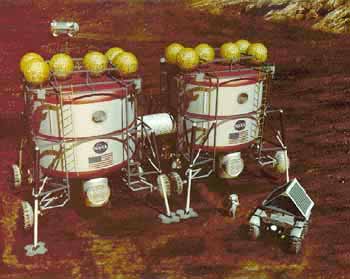 The astronauts would arrive on the
surface in the same module that was used for transit to Mars. The logical
crew habitat module would be a cylinder with a diameter of 7.5 meters and
an overall height of about 6 meters. The module is divided into two
levels, each approximately 3 meters in height. In total, this
configuration translates into a total of about 960 square feet. Equipment
sent ahead of the astronauts might include a laboratory, similar in shape
and size to the habitat module, a fully-fueled pressurized surface rover,
and other scientific equipment and consumables.
The astronauts would arrive on the
surface in the same module that was used for transit to Mars. The logical
crew habitat module would be a cylinder with a diameter of 7.5 meters and
an overall height of about 6 meters. The module is divided into two
levels, each approximately 3 meters in height. In total, this
configuration translates into a total of about 960 square feet. Equipment
sent ahead of the astronauts might include a laboratory, similar in shape
and size to the habitat module, a fully-fueled pressurized surface rover,
and other scientific equipment and consumables.
After arrival, the astronauts would check and organize their equipment, set up a power system and retrieve and check the components that arrived separately. The astronauts would then conduct previously-planned experiments and their findings may determine the direction of further investigations. Investigations into the geology and mineralogy of the area surrounding them would be carried out, and astronauts would look for water in the soil, perhaps even drilling deep into the surface to search for water reserves. The crew would communicate their findings to scientists and the public on Earth, and receive instructions for future experiments.
